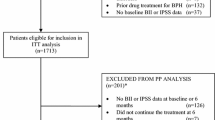Abstract
To determine the effect of phytotherapy (Serona repens) on the clinical progression in men with mild symptoms of bladder outlet obstruction (BOO). A total of 189 patients with mild symptoms of BOO, recruited from four different European clinics, were included in the analysis. Age, prostate specific antigen (PSA), international prostate symptom score (IPSS), quality of life (QOL), maximum urinary flow rate (Qmax) and total prostate and transitional zone volume were recorded. Clinical progression was defined as change from the mild-IPSS group into the moderate or severe group or the occurrence of urinary retention and need of surgery. Cumulative progression rate was 1, 7, 9 and 16% at 6, 12, 18 and 24 month, respectively, for the active group (Serona repens) as compared to 6, 13, 15 and 24% for the watchful waiting group. (P=0.03) significant improvements in the Qmax, IPSS and QOL were seen in the group receiving Serona repens. Serona repens significantly reduced the clinical progression rates in men with mild symptoms of BOO. It also led to improvements in urinary symptoms, QOL scores and urinary flow rates.

Similar content being viewed by others
References
Oishi K, Boyle P, Barry MJ (1998) Epidemiology and natural history of BPH. In: Denis L, Murphy G, Khoury S (eds) 3rd International consultation on BPH. Jersy, Scientific Communications International
Welsch G, Weinger K, Barry MJ (2000) Quality-of-life impact of lower urinary tract symptom severity: results from the health professionals follow-up study. Urology 59:245–250
Girman CJ, Jacobsen SJ, Tsukamoto T, Richard F, Garraway WM, Sagnier PP, Guess HA, Rhodes T, Boyle P, Lieber MM (1998) Health-related quality of life associated with lower urinary tract symptoms in four countries. Urology 51:428–436
McConnell JD, Barry MJ, Bruskewitz RC (1994) Benign prostatic hyperplasia: diagnosis and treatment. Clinical practice guideline, number 8. AHCPR publication no. 94-0582. Rockville, MD, Agency for Health Care Policy and Research, Public Health Service, US Department of Health and Human Services
Djavan B, Wammack R, Dobrovits M, Bagheri F, Kramer G, Hruby S, Chaudry A, Andreas Reissigl, Alexandre Zlotta, Marberger M (2002) Predictors of progression in men with mild symptoms of bladder outlet obstruction. J Urol 167(Suppl):268, A1054
Marwick C (1995) Growing use of medicinal botanicals forces assessment by drug regulators. JAMA 273:607–609
Astin JA (1998) Why patients use alternative medicine: results of a national study. JAMA 279:1548–1553
Furnham A, Forey J (1994) The attitudes, behaviors, and beliefs of patients of conventional vs complementary (alternative) medicine. J Clin Psychol 50:458–469
Descotes JL, Rambeaud JJ, Deschaseaux P (1995) Placebo controlled evaluation of the efficacy and tolerability of Permixon in benign prostatic hyperplasia after exclusion of placebo responders. Clin Drug invest 9:291–297
Cukier J, Ducasso J, Le Guillou M (1999) Permixon versus placebo. Results from multicenter trial. CR Ther Pharmacol Clin 4:15–21
Carraro JC, Raynaud JP, Koch G, Chisholm GD, Di Silverio F, Teillac P, Da Silva FC, Cauquil J, Chopin DK, Hamdy FC, Hanus M, Hauri D, Kalinteris A, Marencak J, Perier A, Perrin P (1996) Comparison of phytotherapy (Permixon) with finasteride in the treatment of benign prostatic hyperplasia: a randomized international study of 1098 patients. Prostate 29:231–240
Grasso M, Montesano A, Buonaguidi A, Castelli M, Lania C, Rigatti P, Rocco F, Cesana BM, Borghi C (1995) Comparative effects of alfuzosin versus Serona repens in the treatment of benign prostate hyperplasia. Arch Esp Urol 48:97–103
Gerber GS, Kuznetsov D, Johnson BC, Burstein JD (2001) Randomized, double-blind, placebo-controlled trial of saw palmetto in men with lower urinary tract symptoms. Urology 58:960–965
McConnell JD, Roehrborn CG, Baustita OM, Andriole GL, Dixon CM, Kusek JW, Lepor H, McVary KT, Nyberg LM, Clarke HS, Crawford ED, Diokno A, Foley JP, Foster HE, Jacobs SC, Kaplan SA, Kreder KJ, Lieber MM, Lucia MS, Miller GJ, Menon M, Milam DF, Ramsdell JW, Schenkman NS, Slawin KM (2003) The long-term effect on doxazosin, finasteride, and combination therapy on the clinical progression of benign prostatic hyperplasia. N Engl J Med 349:2387–1398
Boyle P, Robertson C, Lowe F, Roehtborn C (2000) Meta-analysis of clinical trials of permixon in the treatment of symptomatic benign prostatic hyperplasia. Urology 55:533–539
Kaplan SA, Goluboff ET, Olsson CA, Deverka PA, Chmiel JJ (1995) Effect of demographic factors, urinary peak flow rates, and Boyarsky symptom scores on patient treatment choice in benign prostatic hyperplasia. Urology 5:398–405
Author information
Authors and Affiliations
Corresponding author
Rights and permissions
About this article
Cite this article
Djavan, B., Fong, Y.K., Chaudry, A. et al. Progression delay in men with mild symptoms of bladder outlet obstruction: a comparative study of phytotherapy and watchful waiting. World J Urol 23, 253–256 (2005). https://doi.org/10.1007/s00345-005-0005-7
Received:
Accepted:
Published:
Issue Date:
DOI: https://doi.org/10.1007/s00345-005-0005-7




